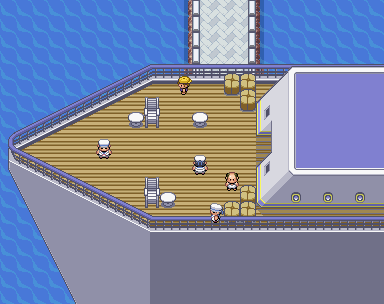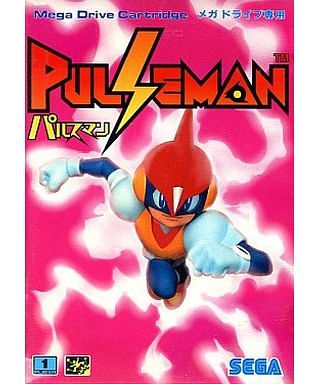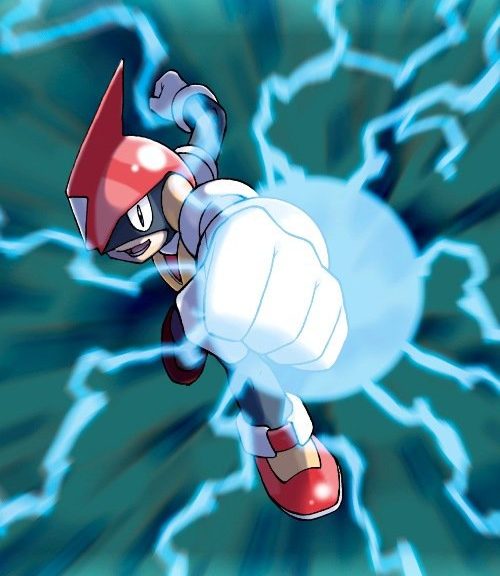Pulseman – Rotom in disguise
Before Game Freak created Pokémon, they did other titles such as Pulseman. Find out how this title has been referenced time and again!
People frequently make references to external things in their work, be it to stories they like, or in-jokes between themselves and friends. This extends to Game Freak members as well! Some of their references within Pokémon are to other games – and interestingly they’re often games they had made themselves.
The prime example of this is an old Mega Drive (also known as the Sega Genesis) action platform game called Pulseman. In this game, you play as Pulseman, an AI character of sorts who can control electricity and travel in the real world and cyberspace. He takes on his “father” who had turned evil. The game lacks collecting monsters in capsules for the sake of battling with others, but there’s many a borrowed aspect from Pulseman within the Pokémon games. This isn’t surprising when you notice the development team included the likes of Ken Sugimori and Junichi Masuda, who have acted as director, artist, and composer amongst other roles of the main series Pokémon titles.
Let’s see what references have been made to the Pulseman game within the Pokémon franchise! We’ll go in order of game releases.
The S.S. Anne
The earliest is an often-missed reference in the name of a certain boat well known by those who played any of the games set in Kanto, such as Pokémon Red and Blue.

The boat is known to us as the S.S. Anne, but the Japanese name can be translated as the St. Annu (サント・アンヌ号). Meanwhile, in Pulseman there are various ‘ultra computers’ connected together. Pulseman had been created on one of these computers. Furthermore, these computers were connected to a larger one called ‘Saint Anne’ (サント・アンヌ). The ship’s name hence is a reference to the computer.
The choice of name of the artificial life form in Pulseman appears a bit odd – at best one can suggest it’s a vague biblical reference to Saint Anne, mother of Mary (in turn the mother of Jesus). Given Pulseman had been born on one of the computers serving under Saint Anne, you could say then that it was the “mother” or guardian of said computer. There’s nothing like that to glean from the name’s usage in the Pokémon games however – it’s merely a reference.
Gun Fish
The sixth stage of Pulseman (called Australia) is a water-themed stage, where Pulseman chases after the villains who are using a submarine. Much like Australia, deadly enemies await Pulseman here, including a robotic gun fish enemy.

That’s not the only gun fish Game Freak has created. Remoraid is a Pokémon modelled on a fish with a gun motif. It and its evolution in Octillery had a stronger gun and tank themed motif behind them in beta designs, before they were toned down for the final release of the second generation games, Pokémon Gold and Silver. The idea was probably good enough for Game Freak to reuse, only for the gun motif to be downplayed by making Remoraid’s body closer to an actual fish, perhaps for marketing or game rating reasons.

Volt Tackle
Volt Tackle, the move Pikachu has been able to learn ever since the end part of the 3rd generation (around when Pokémon Diamond and Pearl would have been in development, which is relevant for the next few entries) is also inspired by Pulseman’s signature move ‘Volteccer’, the same as the Japanese name for Volt Tackle. Whenever Pulseman used it he would be covered in sparks and able to bounce around the stage, or you may even say fly across the stage, not too unlike how the move works in Super Smash Brothers.
Volt Tackle has remained unique to the Pikachu line ever since, and has been showcased numerous times in the Pokémon anime as a result. This isn’t the only time a reference to Pulseman has become a significant aspect of the Pokémon series however…
Rotom

Pulseman had been born from the computer mentioned above, and came equipped with electrical powers. He could move in the real world as well as cyberspace by entering computers. He also has a red headpiece with a spike on the top, which almost reminds you of a certain Pokémon that can possess electronics… one introduced in the fourth generation games.
There’s some other possible resemblances with other Pokémon (such as Bisharp), but this seems to be the most obvious with appearance with the headgear and the whole electricity theme coupled with it. Rotom can also be based on a ball of plasma… a form Pulseman takes when beginning stages.
Rotom itself had an interesting beginning to the franchise, appearing in one haunted room in Pokémon Diamond and Pearl, and being given the Legendary Battle theme despite not being classified as a Legendary Pokémon. In Pokémon Platinum, it was then granted a whopping five alternate forms (each made by a different artist). Many of these forms have since starred in competitive formats. This addition to Rotom came with a backstory involving a new Platinum-exclusive character, Charon.
But that wasn’t all the love this Pokémon born from a reference to Pulseman received. In generation six Rotom was used as part of the Rotom Dex, which many players of Pokémon Sun and Moon and especially Pokémon Ultra Sun and Ultra Moon will remember. Bzzt! It featured heavily in the Pokémon anime season corresponding to those games as well. Then in Pokémon Sword and Shield, Rotom served as part of the Pokémon Storage system, appearing in every Pokémon Centre as part of the PC.
Pulseman was so well liked that its spiritual (pun unintended) successor in Rotom got a lot of limelight.
Team Galactic
Rotom debuted in generation four, and evidently wasn’t the only case where Pulseman was on the minds of the developers. The villainous team of the Sinnoh region, Team Galactic, had the Japanese name of ギンガ団 – “Ginga-dan”, which translates literally as Galaxy Gang. (As an aside, other Teams are called Gangs in Japanese – this is a byproduct of localisation.) In Pulseman, the antagonistic group you battle against is also called the Galaxy Gang.
There’s no similarities between the two beyond name, however. Team Galactic in Pokémon have Admins named after planets (or moons of dwarf planets in the case of non-admin Charon), while the Galaxy Gang in Pulseman did not have any other astronomy-based theming. Meanwhile, Team Galactic tried to make a new universe. The Galaxy Gang just wanted to conquer via cyber-terrorism.
Musical references
The fourth generation Pokémon games even included a musical reference as well to Pulseman. Take Barry’s battle theme, the hyperactive rival of the Sinnoh games. Parts of it certainly crop up in sections the Neo Tokyo theme from Pulseman, such as around 0:36 and 0:34 respectively.
Other titles referenced
Game Freak hasn’t only done Pulseman in the past however. A more recent title is Drill Dozer, a Game Boy Advance game which also likely got some allusion to it in Pokémon Diamond and Pearl. The game involves, unsurprisingly, drills, as well as items such as the Red, Green, Yellow and Blue Diamonds, a reference to the generation one Pokémon titles. In turn, these items appeared in Sinnoh’s Underground. A drill is also a Key item required to make a Secret Base in those games. The fifth generation titles in Pokémon Black and White is also not without its nods to the series, with the Drilbur possibly influenced by the Drill Dozer’s design and techniques (specifically the attack Drill Run).
And the references go both ways too. Rhythm Hunter: HarmoKnight, is another Game Freak game released as a digital-only 3DS title. It’s a rhythm game that features five Pokémon-themed levels in it, complete with remixed Pokémon music.

Who knows what other references to Game Freak games will crop up in Pokémon? As long as members from past and possible future projects stay on the Pokémon scene, one shouldn’t be surprised to continue to see small nods to their own works. In fact, there’s been other musical references throughout the years not mentioned here – but that’s for another article.

Article originally on Wynaut?, with new additions made.
Thanks to Cherrim for translations.
Edited by Dragon, Rivvon, and Zach.
